Please Take Note: This is a review of the final game, but it might change slightly based on the success of the Kickstarter campaign. The game is being reviewed on the components and the rules provided with the understanding that “what you see is not what you might get” when the game is published. If you like what you read and want to learn more, we encourage you to visit the kickstarter campaign. Now that we have all that disclaimer junk out of the way, on with the review.
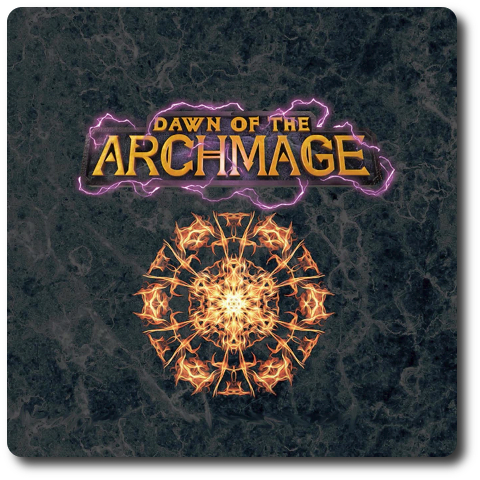
The Basics:
- For ages 8 and up
- For 2 to 4 players
- Approximately 60 minutes to complete
Geek Skills:
- Active Listening & Communication
- Counting & Math
- Logical & Critical Decision Making
- Reading
- Strategy & Tactics
- Risk vs. Reward
- Hand/Resource Management
Learning Curve:
- Child – Easy
- Adult- Easy
Theme & Narrative:
- Best your rival in a contest of magic and wit!
Endorsements:
- Gamer Geek mixed!
- Parent Geek approved!
- Child Geek approved!
Overview
Magic has ruled the land for centuries and those who controlled magic ruled absolutely. But times are changing. Kingdoms are growing in strength and magic is no longer the strongest power in the land. The highest ranking mages have gathered and agreed that one among them must lead and challenge those who would attempt to steal their power. The only problem is, no one can agree who should be the Archmage.
Dawn of the Archmage, designed by Dave Killingsworth and to be published by SolarFlare Games, will reportedly be comprised of 200 Archmage cards, 200 Health tokens, 30 Terrain Modifier tokens, 24 Terrain Modifier cards, 20 Creature miniatures, 20 miniature base covers, 20 Fatigue tokens, 18 Map tiles (double-sided), 12 dice, 8 Summoning Power Crystal tokens, 8 Soul Stone tokens, 8 Summoning Portal tokens, and 4 Mage placards (double-sided). As this is a review of a prepublished game, I cannot comment on the game component quality.
Arcane Study
To set up the game, first create the map configuration using the Map tiles. The game comes with a few suggested configurations for 4, 3, and 2-player games consisting of 2×2, 3×3, 2×1, and “T” shaped configurations. Place any Map tiles not used back in the game box.
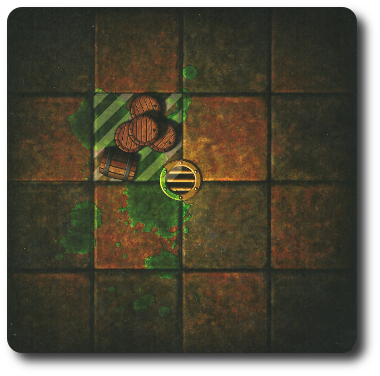
Example Map tile
Second, organize the Archmage deck into the four different schools. These are “Necromancer”, “Technomancer”, “Elementalist”, and “Demonologist” schools of magic. Shuffle each of the four piles separately and place them face-down. These are the Schools of Magic decks. The cards within them are referred to as Archmage cards.
Third, determine which player will go first and have them select a Mage placard. Players then take turns, going in clockwise order, picking their Mage placards. These placards should be placed in front of their owning player. One side shows the image of a female and the other a male. The sex of the would-be Archmage is inconsequential to the game. This sex of the mage is purely player preference, but the selected placard determines the School of Magic.

Bald is beautiful…
Fourth, each player is given 5 Fatigue tokens, 2 matching Soul Stone tokens, 2 Summoning Power Crystal tokens, 50 Health tokens (10 in each color), and 3 dice.
Sixth, give each player 5 Creature miniatures that match their selected team, along with 5 miniature base covers.
Seventh, each player draws 3 cards from their School of Magic deck. Place any remaining counters and tokens to one side and within easy reach.
That’s it for game set up. Time to see who is worthy of the title “Archmage”.
Power Struggle
Dawn of the Archmage is played in rounds, turns, and phases. Each player’s turn is comprised of 4 phases which are summarized here.
Phase 1: Summoning
If the player has a “Creature” Archmage card in their hand, they may summon it, but only if they have a charged Summoning Power Crystal or a Soul Stone available. In addition, a player must have a vacant and available summoning portal that can be used to magically bring the creature forth into the world. If the player can meet these requirements, they place a “Creature” Archmage card face-up in an open creature slot on their placard and announce they are summoning it. The player must immediately turn over a Summoning Power Crystal or Soul Stone that has been charged, thus using its charge. The player must “pay” for each level of the creature. For example, a level 2 creature must be paid for by using 2 Summoning Power Crystals, 2 Soul Stones, or a combination of the two. A level 0 creature is summoned for free but must still have the space to be placed.
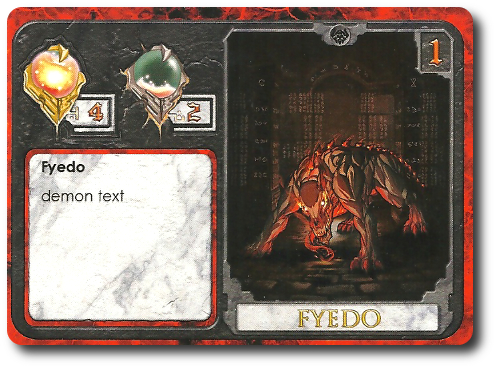
A loyal demon dog to summon at your side…
The player then grabs a miniature with a base of the same color as the creature slot on their placard and places it on an open summoning portal on the map. Then the player place next to the miniature a number of Health tokens as defined by the “Creature” Archmage card.
A player can, if they so choose, sacrifice a summoned creature and use its energy to charge a Summoning Power Crystal or Soul Stone token. Only creatures that have been damaged and are currently located on the summoning portal can be sacrificed. Once sacrificed, the creature is removed along with any still attached Health tokens.
Phase 2: Movement
The player now rolls 2 dice, adding the map size adjustment value. This is the player’s “movement energy” for their turn. For example, a map comprised of 3×3 Map tiles would mean a player determines their total movement energy by rolling 2 dice and then adding “+3” to the rolled value.
It costs 1 movement energy to move a Creature miniature one space to an adjacent space or 2 movement energy to move diagonal. For the most part, a Creature miniature can only move orthogonally with a few map-based exceptions.
Movement energy is divided up among all the player’s current Creature miniatures on the map. A player need not use all their movement energy if they do not want to. Various movement restrictions apply. Mostly on the order of not being able to move through various map terrain (summoning portals and walls) and limitations to how many creatures can occupy a space at the same time. The map can be changed during game set up to include additional obstacles or can be altered during game play.
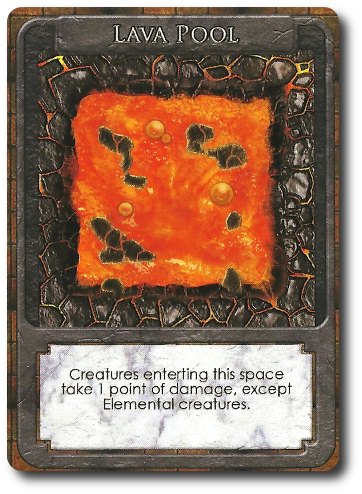
Phase 3: Combat
If a player moved any of their Creature miniatures into the same space as an opponent’s Creature miniature, combat ensues. The player taking their turn decides the order in which all combat is resolved.
Each player involved in combat now rolls a number of dice equal to the Creature level in combat and the Creature’s current Health. In this way, as a monster fights and takes damage, they will become less and less effective in battle. The Creature’s “fatigue value” will also determine how many dice are rolled. Players should pay close attention to any special rules their Creature may utilize. Terrain modifiers may be in use that alter the rules, as well.
Spells can be used at this time. Each “Spell” Archmage card describes how it can be used and when.
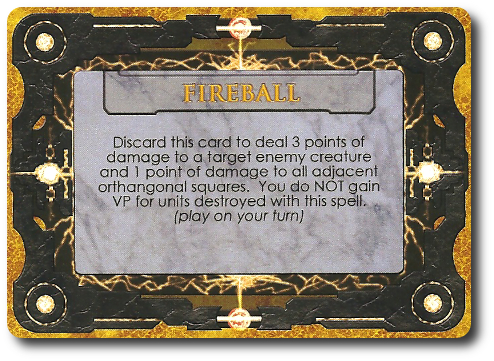
Once the dice are rolled and any bonuses and penalties are applied, the final values are compared. The player with the highest value wins. The difference between the two player’s rolls is determined and the losing Creature reduces their Health tokens by an equal number. If the last of the Creature’s Health tokens are removed, the Creature is removed from the map and the winning player takes the Creature card, adding it to their victory point pile. If the Creature remains, but its Health value is less than or equal to its “fatigue value”, it takes a Fatigue token.
Another fight can then happen if the losing player’s Creature only lost 1 Health token or they may decide to retreat. A retreat is done by rolling a single die and moving that number of spaces away, counting the number rolled as movement energy. The direction the Creature moved is indicated by the retreat card. If the retreat direction and movement would take the Creature off the map, into a space occupied by two creatures or pass through impassable terrain, it remains where it is and must fight again. If the movement would take the creature into a space occupied by only one other creature, it moves and must fight the new opponent.
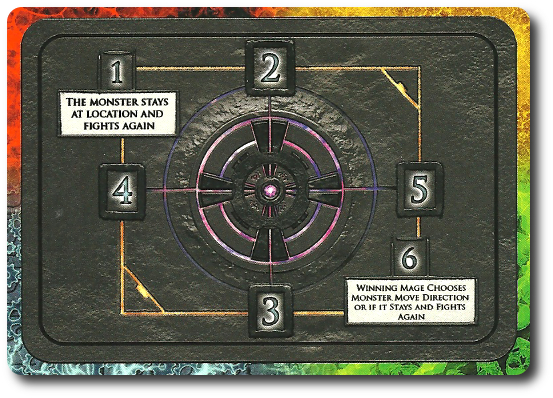
Combat continues until all creatures are occupying a space by themselves.
Phase 4: Wrap-Up
During the final phase of a player’s turn they have the option to summon additional Creatures. The rules to summoning are the same found in the Summoning phase, however, no sacrifices are allowed.
Finally, the player draws 2 Archmage cards from their respective School of Magic deck. This ends the player’s turn and the next player in turn order sequence now goes.
Magnus Supreme
The game continues with each player taking one turn per round until one player has earned enough victory points to win. Each “Creature” Archmage card has a victory point value equal to its level. For example, a level 3 creature is worth 3 victory points. The first player to earn 8 victory points wins the game and is given the coveted title, “Archmage”.
To learn more about Dawn of the Archmage, visit the kickstarter campaign.
Final Word
 The Child Geeks enjoyed themselves. According to one Child Geek, “What I like best about this game is that you control what monsters come out and when to fight them.” This is an important point the Child Geek is making. Players have a lot of control over their forces on the battlefield. A smart and strategic player will quickly see that spending too little to bring out weak monsters and paying too much for stronger monsters has its ups and downs. The middle way certainly seems like a good approach, but with ever-changing battle conditions in place, a player has the freedom to take advantage of any windfall or avoid a misstep. Another Child Geek said, “I didn’t feel like a magic user, but I did feel like a dungeon master!” The game’s theme was well received by the Child Geeks and they played the game with enthusiasm. When the last spell was cast, all the Child Geeks voted to approve Dawn of the Archmage.
The Child Geeks enjoyed themselves. According to one Child Geek, “What I like best about this game is that you control what monsters come out and when to fight them.” This is an important point the Child Geek is making. Players have a lot of control over their forces on the battlefield. A smart and strategic player will quickly see that spending too little to bring out weak monsters and paying too much for stronger monsters has its ups and downs. The middle way certainly seems like a good approach, but with ever-changing battle conditions in place, a player has the freedom to take advantage of any windfall or avoid a misstep. Another Child Geek said, “I didn’t feel like a magic user, but I did feel like a dungeon master!” The game’s theme was well received by the Child Geeks and they played the game with enthusiasm. When the last spell was cast, all the Child Geeks voted to approve Dawn of the Archmage.
 The Parent Geeks also found the game to be entertaining and engrossing. According to one Parent Geek, “I found the game to be very streamlined, despite the fact that everything I can do on my turn is a bit randomized due to the cards. Even so, I never found myself short of options.” The cards in the game do drive a lot of the player’s actions, but there is always something to do. In fact, I’d venture that none of our Parent Geeks ever felt they were short on options. In fact, I heard a few times that the Parent Geeks felt a bit overwhelmed. As one Parent Geek put it, “The game changes quickly and you have to keep your wits about you. Nothing feels like a bad move, but you won’t know until you try.” The game moves at a fast clip (despite being an hour-long or slightly more), keeping the players engaged. All the Parent Geeks voted to approve Dawn of the Archmage, finding it easy to learn and fun to play.
The Parent Geeks also found the game to be entertaining and engrossing. According to one Parent Geek, “I found the game to be very streamlined, despite the fact that everything I can do on my turn is a bit randomized due to the cards. Even so, I never found myself short of options.” The cards in the game do drive a lot of the player’s actions, but there is always something to do. In fact, I’d venture that none of our Parent Geeks ever felt they were short on options. In fact, I heard a few times that the Parent Geeks felt a bit overwhelmed. As one Parent Geek put it, “The game changes quickly and you have to keep your wits about you. Nothing feels like a bad move, but you won’t know until you try.” The game moves at a fast clip (despite being an hour-long or slightly more), keeping the players engaged. All the Parent Geeks voted to approve Dawn of the Archmage, finding it easy to learn and fun to play.
 The Gamer Geeks, having a great deal of experience in the areas of miniature combat, magic wielding, and card/resource management didn’t see much in Dawn of the Archmage that was terribly new. According to one Gamer Geek, “I see the shadows of other games that have influenced this one, but I’m pleased that the game itself is standing out on its own.” Another Gamer Geek said, “I think the final game will be a fun one to play, but I’m not convinced that it will be great given what limited components we have been provided.” The Gamer Geeks were cautious about their endorsement, finding the game to be intriguing, but still not yet complete enough to warrant their full love. All the Gamer Geeks agreed that they liked what they were seeing, finding the game to be strategic and tactical, but they disagreed on what that meant to them at the end of the day. As a result, the Gamer Geeks provided a mixed level of endorsement.
The Gamer Geeks, having a great deal of experience in the areas of miniature combat, magic wielding, and card/resource management didn’t see much in Dawn of the Archmage that was terribly new. According to one Gamer Geek, “I see the shadows of other games that have influenced this one, but I’m pleased that the game itself is standing out on its own.” Another Gamer Geek said, “I think the final game will be a fun one to play, but I’m not convinced that it will be great given what limited components we have been provided.” The Gamer Geeks were cautious about their endorsement, finding the game to be intriguing, but still not yet complete enough to warrant their full love. All the Gamer Geeks agreed that they liked what they were seeing, finding the game to be strategic and tactical, but they disagreed on what that meant to them at the end of the day. As a result, the Gamer Geeks provided a mixed level of endorsement.
 Do not play this as a two-player game. The joy of Dawn of the Archmage is directly proportional to the number of players fighting you. You can always make the map area less or more tedious by adding additional terrain features, but you cannot find a substitute for good old-fashioned living opponents. Three players is good, but four is best.
Do not play this as a two-player game. The joy of Dawn of the Archmage is directly proportional to the number of players fighting you. You can always make the map area less or more tedious by adding additional terrain features, but you cannot find a substitute for good old-fashioned living opponents. Three players is good, but four is best.
Rules are still being tweaked. In fact, we were given new rules regarding summoning and sacrificing that improved the game play. While the game is not yet “fully baked”, our impression was that it was well enough along to be a solid contender. This, however, did not persuade some of the Gamer Geeks to go “all in” when it came to their endorsements. To some, Dawn of the Archmage still felt like a work in progress. As such, the Gamer Geeks could award the game praise, but not their full approval. Thus the “mixed” endorsement provided by the elitists. A more complete demo copy would have turned the tide, especially if it included the miniatures. Based on what I’ve been told and seen, the final game will be a joy to look at and a real crowd drawer.
The different Schools of Magic are similar enough to be well-balanced, but have distinct features of their own. While each School of Magic does play towards different playing styles, none of them are so wildly different to give the player who wields them a distinct advantage. This is a very good thing, as the School of Magic a player is given is randomized and based on turn order sequence. It also means that a player will never have a true advantage or be at a disadvantage when going toe-to-toe against another player. What will win the day is smart card plays, good resource management, tactical thinking, strategic actions, and daring to push the limits.
Overall, I’m pleased with the game. I found it to be “middle of the road”, as far as games go. Too heavy for a filler and not heavy enough to be the only game in the evening. It fits that nice little space in between for those who are looking to enjoy a good game with depth, but not so deep as to require a great deal of their time. Clocking in at an average game play length of an hour, Dawn of the Archmage provides a higher level of fun and engagement than what you’d expect, but still feels light enough at times to give all the players a moment to catch their breath. Do try this game if miniature battles and throwing fireballs is your thing. While the game did not put all of our players under its spell, there was little doubt that this game has a magic all its own that will be worth exploring.
This is a paid for review of the game’s final prototype. Although our time and focus was financially compensated, our words are our own. We’d need at least 10 million dollars before we started saying what other people wanted. Such is the statuesque and legendary integrity of Father Geek which cannot be bought except by those who own their own private islands and small countries.



